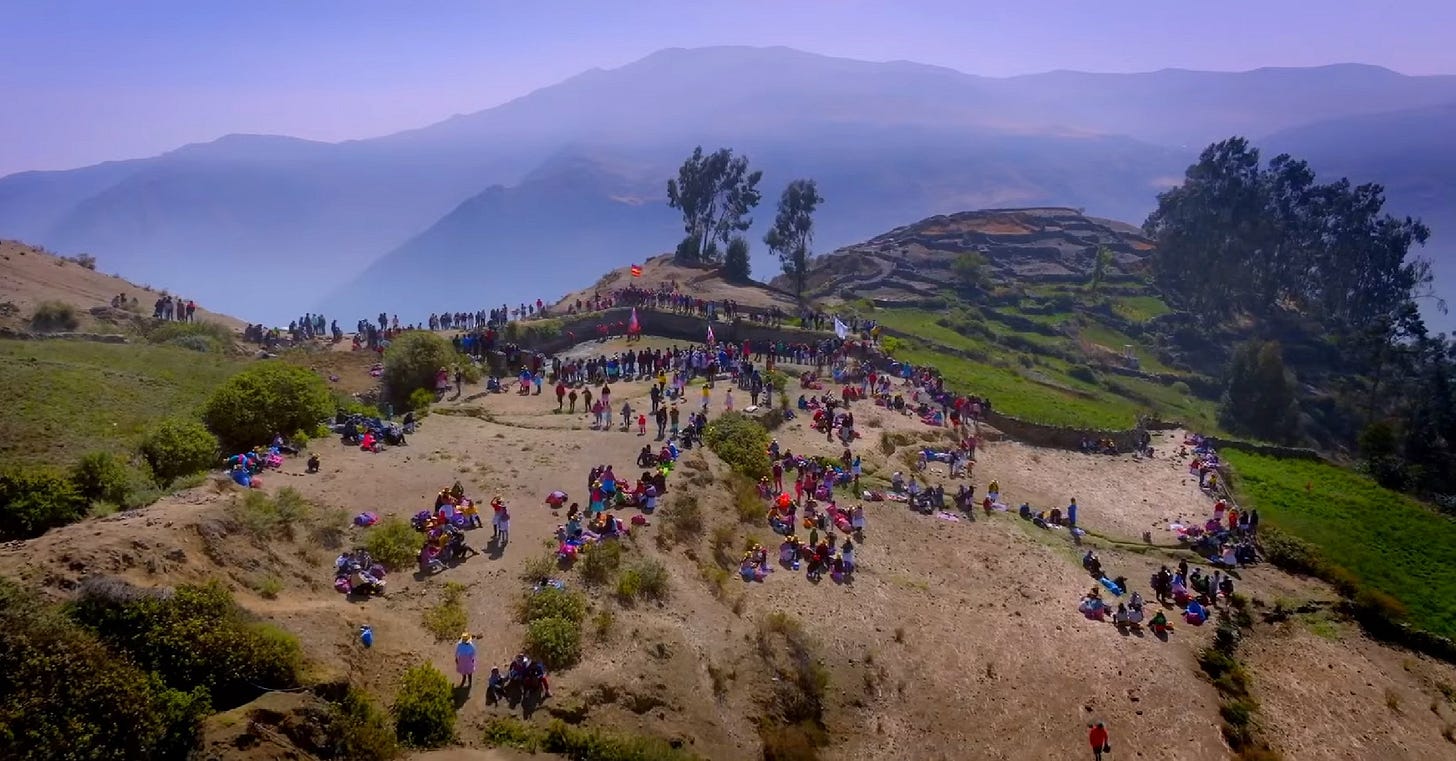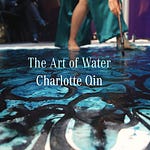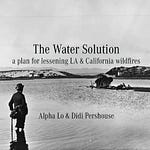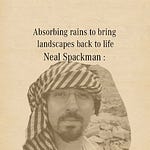A wonderful new documentary, Our Blue World, is out, and it offers a panoramic exploration of how communities across the globe are learning to live in greater harmony with water. The film highlights a wide range of innovative and traditional practices—from China’s sponge city initiative, to New Zealand’s recognition of the Whanganui River as a legal person, to the ancient Peruvian techniques for guiding water into mountains so it reemerges as springs. It also delves into the Biosphere 2 project, where twelve people lived in a sealed dome for two years and had to rely on constructed wetlands to purify their water. The documentary further explores the shift along the Mississippi River from a levee-centered approach to one that embraces wetland restoration, as well as efforts to restore Ireland’s bogs—offering a hopeful vision of how we can reimagine our relationship with water. The film is produced by Paul O’Callaghan, directed by Ruan Magan, and narrated by Liam Neeson (the action movie actor) in his voice that oozes gravitas. The movie has beautiful images, and wonderful music that connects us to the local geography and culture.
[Peru: still from movie].
I think documentaries are a great way to movie the word out about the water cycle, so I was glad for the chance to chat with producer Paul O’Callaghan about the movie.
Trailer:
Here are some abridged excerpts from our conversation, which covered topics from the movie:
On sponge cities
Paul: The idea of a sponge city was very evocative. It captures your imagination. It's like, what is it? It's these two words that you're familiar with, but not together in that context. So anytime I would have talked about this, people became very curious.
I was really lucky that we got introduced to Kong Jin. And I remember the day we had the call. It was chaotic in my house at the time. But we had this really great call with Kong Jin and struck up a very good rapport with him. And he kindly was willing to take part in the film. This was just post COVID-19. So China was locked down pretty much for two plus years. We were at the embassy trying to get our visas and get in, which wasn't easy.
Kong Jin is a revolutionary, a visionary, something of a rebel, and a landscaper architect who felt that China was going in the wrong direction. They were following the West blindly. They were pouring concrete at an absolutely incredible race. And when he looked at that, he thought, that's not the right way to go.
[Kong Jian : still from movie}
He'd grown up in the 1960s in China, where it was a beautiful wonderland. It was a paradise. But nobody listened to him when he said we should embrace traditional ways of managing water like rice paddies, for example, which are stepped and terrest, the nearly room for water to ebb and to flow. That was how people lived for 5000 years along the banks of the Yangtze, the Pearl and the Mekong, where in actual fact, the fitness to govern in China was correlated with your ability to control water or at least live with the ebbs and the flows of those mighty, mighty rivers.
So it's always been something fundamental to Chinese philosophy and political systems. He wrote 500 letters to 500 mayors and it landed on deaf ears. He was cast out as a pariah. Until one mayor, who later became a minister for the environment later on reached out back out to him and said - I'd love to try that idea that you had in Hainan.
That was where the first sponge city was created. And these things look beautiful. When you think about China, oftentimes we think of concrete high rises, skyscrapers, maybe a lot of road traffic and air pollution. Well, these aren't like that at all. Certain parts of the city have tree lined along the streets. They may have mangroves on the coast. There large areas that are allowing rivers to ebb and flow, with constructed wetlands that look like parks.
Alpha: Yeah, it's amazing that he had the persistence to do 500 mayors. It's like sometimes to make these paradigm shifts in work, you really have to push. It reminds me of little Peter Andrews, the Australian guy who did natural sequence farm. He just kept pushing, pushing against and all these people say no. But yeah, it's interesting. Not everyone has that ability to push so hard. And sometimes it takes that to get it out there.
Paul: And you never know, it only has to land with that one mayor, 499 would never have listened to him. When you write these letters, when you advocate, when you communicate, none of us can really understand the wrinkles that are going to take effect downstream of this.
He engendered a spirit of pride in a harkening back to perhaps a wisdom of a 5,000 year old culture. In doing so, he wasn't alienating people with some theory that they wouldn't understand. He was advocating for traditional wisdom.
Alpha: And what is some of that traditional Chinese wisdom?
Paul: We've been trying to flatten a variable signal, particularly in monsoon type climates in South Asia, where you get these incredible flows, certain times of the year, which can cause rivers to burst their banks. Nowhere is that more true than in China. They had names for these rivers. One was called the Scourge of the Sons of Han.
People began to come together and work together in collaboratives, particularly in an agrarian society where the most fertile places are along the banks of these rivers. We saw that in Egypt along the Nile, which, you know, sustained a very rich culture for hundreds, if not thousands of years. And China for five thousand. One of the reasons they haven't had a collapse, like many civilizations have had, is because the rivers constantly replenish nutrients on the lands. They do that by flooding and edding and leaving room for the river.
The concept was don't try to canalize it, channel it, control it, straighten it, put it underground and make it move in straight lines. That's not what water wants to do. And Erica Gies, extremely eloquently, captures this in the idea that ‘water always wins’. It's about the power of a tree to break the fall of the water, slow it down.
In the root zone of these plants, you've got at least the same area taken up as the complete canopy, not to mention the mycorrhizae structure in the root zone, which is acting like an incredible sponge to hold water. He has been able to integrate this into modern cities. He's got at least over 50 sponge cities, if not more now. Others adopting and embracing the same idea, Bangkok and Thailand. You'll see examples in South Korea.
I would say what we see happening in New York, and Copenhagen. Same as in Hamburg, in Germany, New Orleans. And that was one of the interesting things about this film project—you always learn something.
We saw stuff that you could join, but they were arising independently, in synchronicity with one another, without anyone really having got together and come up with any particular master plan. What they found was a swampy area that maybe was low-value property—you know, nobody wants to live there. It was kind of almost wasteland, duck land. But when they went in and regenerated it, rehabilitated it, actually the price of the property increased dramatically—because people now wanted to live there.
In China people were embracing this. Elderly people are out there in the morning, in this wetland natural park, where you can eat fruit from the trees, and there are fireflies buzzing. It sounds idyllic. You’d see young couples on a date walking together, holding hands through this area. You know, people pushing strollers with babies.
The city came alive—through a combination of walkways and boardwalks—in an area that was functioning to protect the city from the disastrous effects of flooding. It was also purifying water. And if you come from a background in water engineering, and you look very closely, you can—you can totally see how the levels are being adjusted, and how it’s flowing from one pond to the next pond, and how it’s all connected.
But you know, for most people, it just looks like a beautiful park. And that’s all they see. But it allows—and then, you know, other things: stress levels go down. When we do these types of things, suppression levels go down. People’s social interactions go up. These are externalities you can’t even measure when you think about these projects.
On the Mississippi
Paul : If you're American, the Mississippi is so iconic. I don't know if you grew up reading Mark Twain or Huckleberry Finn or those kinds of Mark Twain stories. I did. I think for kids all over the world—some of our first romantic, notional images of America came from the idea of two kids going down a river in a raft and having adventures. And that's timeless. It's that freedom that the river brings, the life on the river. It links from the Great Lakes down to New Orleans. It's a mighty, mighty river.
In 1927, they experienced an absolutely incredible flood. That led to the displacement of 400,000 people. Many of those people would have been sharecroppers, people who were already quite poor and not well off to begin with. This is from all the area down towards New Orleans, the Delta—particularly where the blues music was, like Robert Johnson, Lead Belly, Muddy Waters.
Alpha : It was really nice to have the musicians play the blues music in your movie. I really liked that feeling.
Paul : Such a treat—it really was. We wanted to show that rivers help foster culture. Rivers are melting pots. One of the reasons that blues, bluegrass, country, and jazz emerged was that people came together with different influences from different places. It’s a melting pot. We see this in rivers in Colombia with music there too. I'm glad you liked it. For me, that was a real highlight. I grew up loving Muddy Waters and Robert Johnson and Lead Belly and all that music. And it came from this small area—incredibly rich.
When those people moved—many of them moved north to Detroit and took jobs in the automotive industry in the 1930s, 40s, and 50s—and to Chicago, it was one of the reasons why blues music took hold in Chicago and why Motown exists in Detroit. There’s an interesting cultural aspect that the flood had as a knock-on effect.
That was 1927, and they haven't seen a flood like that since, but there are times when it gets close—dangerously close. So the mayors along the river realized that there's no levee you can really build that will be powerful enough to protect you. But one of the things they're doing is finding node points all down the river to just leave a bit of breathing room, like a pressure relief valve, where they can set aside areas that can take that water, hold it, and release it back in slowly. That’s their approach, and they're doing it quite collaboratively. Because if they don't, they could be looking at something like 1927 again.
Alpha : So they're building all these wetlands. It's a different approach than levees, to deal with the overflow.
Paul : A levee is a Victorian hard engineering solution. “We can do this. We can control. We are in charge of this situation. We dominate nature. We have dominion over nature.” That idea is a 19th century, maybe even 18th century idea that worked—particularly when you'd see a one-in-a-hundred-year storm every hundred years. But that's no longer the case.
A levee is a hard answer to a problem. A dam is the same. And we're now getting rid of some of these dams as well. We've interrupted the flow in 80% of the world's rivers. We've drained our wetlands. This has been the direction of travel. But now the idea is to leave room.
And you know, it’s funny—the Dutch live underwater. And every Dutch person knows that. They're incredible masters of water engineering. They have dikes and levees. But even there, they're leaving room for the river. They're allowing rivers to expand and flood in a way that wasn't part of the traditional Dutch approach. And that's the approach we’re seeing adopted up and down the banks of the Mississippi.
Alpha: In hydrology, there's the idea of gray infrastructure—all the dams and levees, the concrete—and then there’s the idea of green infrastructure, like wetlands. There is a switch to the paradigm of a living river, as opposed to forcing the river to do what we want.
Paul: When you get atmospheric rivers in the sky, and you can see in Spain, for example—in Valencia—you can get a year’s worth of rain falling in an hour. You see cars washed up and down the street of a Spanish town. Nothing we’ve built is in any way prepared for that.
I think it’s like that story of King Canute trying to stop the tide from coming in. Good luck with that. These other solutions make imminently more sense—financially, ecologically, from a biodiversity perspective. The race now is to cross-pollinate ideas between, say, civil engineering within a city council—where that department has that job—and new approaches.
Even the city where I live, in Cork, I’ve been terribly disappointed to see hard flood defenses going up on that river, up to maybe a meter, 1.5 meters. One thing is, it isolates people from their river. You can barely see it. It’s like there’s a barrier. And it’s not going to work anyway, because eventually the water’s going to come up through the manholes or some other way.
I’m just disappointed that, unfortunately, people are still doing what they always did—because that’s what they learned in university—instead of looking around the world and saying, “Hey, look, there are people doing things differently.” These are what we call the lighthouses. If you look and see, “Oh, they're doing this in Shanghai,” or “Oh, it’s working in Beijing,” or “It’s working in Bangkok.”
I’m not saying there’s no room for gray infrastructure at all. But the sole reliance on it—the idea that it’s the only solution—is very myopic. It's Maslow’s Law of the hammer: if you pour concrete, every problem looks like it can be fixed with concrete.
In one sense, it’s easy. You work out your designs, you draw it up, and you pour your concrete. But maybe it’s more of a headache for the people in the city council to say, “Oh, maybe we’ve got to leave a bit of room further upstream there. Maybe we need to work with the landowner, work with the farmers.” But ultimately, that’s going to give a better solution. It’s like taking a headache pill versus thinking, “Maybe I should rehydrate so I don’t get headaches in the first place.”
Alpha : In the movie, you show the different mayors—how they’re actually speaking with other mayors along the river, which is an interesting way to manage it. It’s almost like a communal thing. Elinor Ostrom, the Nobel Prize-winning economist, called this polycentric governance—where you have multiple centers of decision-making. It seems like that’s what was happening along the Mississippi River: the mayors were talking to each other to help manage the floods.
Paul: The nice thing is, it’s not a partisan issue. It doesn’t recognize party lines. Whether you’re a Democratic mayor or a Republican mayor, the people in your city experience a flood in the exact same way. So people came together and collaborated on this unifying issue—rather than a divisive one.
And if you think about it, cities are where the people live. It’s almost like a return to the idea of the city-state—like Venice once was in Italy. I do think that a city like New York or New Orleans, with the population and the power of the mayor, can have a strong influence.
If you view the river as the natural connection point between cities on its banks, you get a very natural form of polycentric governance—unified by shared interest. Because they are all reliant on this river for transportation, for water, for agriculture.
On how to clean our waters with natural processes
We also talked about topics outside the movie, like John Todd’s work.
Paul: The idea that moss could be used to purify water is fascinating. We can embrace these blue-green infrastructure solutions using constructed wetlands. Willow coppicing is brilliant in its own right. A lot of biological purification processes are simply accelerations of natural processes, natural cycles. And we can go towards circular economy solutions where we can even produce moss bioplastics or alternative feedstocks that are not coming from petrochemicals but are coming from other cellulose or sugar-based feedstocks. There's a ton of exciting things happening in that area.
Alpha: Are you aware of John Todd's work with the living machines?
Paul: Oh yeah—when you look at nature-based solutions, all roads lead to John Todd. It’s like tracing the start of the Big Bang. My very first proper job, after I came back from Malaysia and studied water with the World Wildlife Fund and completed my master's, was with the cosmetics manufacturer The Body Shop. They had a living machine, and it was pretty much John Todd's design—maybe licensed in the UK, but still his vision. Completely inspirational. John Todd continues to have an impact. He's still alive, thankfully. But his approach, once viewed as fringe in the 1960s through the '90s, is no longer marginal.
John Todd’s idea was to replicate natural purification in a controlled way. Wetlands purify water much like kidneys do in our bodies. The system I worked in was a greenhouse filled with round tanks and floating rafts covered in reeds—phragmites, typha. It looked like something from the banks of the Nile, lush and vibrant. My job was to figure out how it worked because no one at The Body Shop really knew. Walking into it didn’t feel like entering a wastewater plant—it was like stepping into a jungle. And you had to manage it: cut back reeds, manage flows.
Todd's genius was in harnessing biodiversity. In the root zone of the rafts, bacteria would grow—microbiomes forming on the roots—and they’d build the base of a food web: rotifers, protozoa, and higher life forms all interacting, breaking down waste, recycling, and purifying water. And it worked—very well.
The microbiome essentially learns to clean. It adapts, much like your gut microbiome adapts when you eat a diverse diet. If that system sees chemicals coming from shampoos or conditioners, its diverse microbial population can start processing them—so long as it’s not overloaded. The Body Shop used natural ingredients like Brazil nut oil, but also detergents like sodium laureth sulfate and preservatives like methylparabens. The living machine handled them, provided the load wasn’t too heavy.
Overload was exactly the issue I had to deal with. There’s a tipping point: if too much comes in too fast, the aerobic system can’t keep up. Aerobic metabolism is key. It’s like how we function—until we hit our anaerobic threshold and get muscle cramps. Similarly, when you lose oxygen in these systems, you get objectionable odors from sulfur-reducing bacteria. Keep it aerobic and it works well. But hit it too hard and oxygen levels fall off a cliff—and performance collapses.
There were also funny side effects. We were using shampoos, so there was foam. A lot of foam. Sometimes on Mondays we’d arrive to find a 12-foot wall of strawberry-scented foam—a byproduct of weekend production. It was hilarious, but also a design challenge.
The system was made of a sequence of tanks—two trains of eight, sixteen total. When you charted the chemistry, tanks one and two did the heavy lifting. The rest? Polishing. Removing trace elements you didn’t want reaching the environment. You could have one big tank, but the sequential approach allowed for each stage to refine the water further. First tanks removed bulk contaminants. Final tanks added the finishing touch.
It’s amazing to think how green this paradigm is—so different from chemical treatment. Findhorn, in Scotland, runs its whole village wastewater system using this approach. That system was designed by Galen Fulford with Aquamatrix, and it’s a mirror image of the one I worked on. These systems all trace back to John Todd. It’s hard to say how many are out there now—but it's definitely in the hundreds, possibly thousands.
San Francisco Water uses this method in urban buildings. Mars—the candy company—uses it. Organica in Hungary deploys it. It's a mainstream solution now. It's what happens in nature, after all. This planet has been purifying water through ecosystems for billions of years. These systems are just miniature biospheres—internalized ecosystems.
You’ve probably heard of Biosphere 2—that radical project in Arizona in the early 1990s where eight people lived in a sealed geodesic dome for two years. It had a rainforest, a coral reef, a desert—all built under a giant glass structure in the middle of the Sonoran desert. Inspired by Buckminster Fuller’s designs, it was built by the Institute of Ecotechnics, a group of visionary thinkers who called themselves something like "a bunch of visionaries in search of the impossible." They sealed it tight, and for two years, the crew had to survive off only what they grew, breathing only the air inside, drinking and recycling the same water—cleaned through living systems.
You don't come out of that the same person. Living inside a miniature Earth forces you to confront the reality of closed-loop systems—where nothing leaves and everything must be accounted for. It's a reflection of the larger truth: our planet is a giant living machine, and our best shot at sustaining ourselves is to work with, not against, those natural processes.
You can see more about the “Our Blue World” movie here : www.braveblue.world
If you would like to show the movie in your area, reach out to the documentary team.
…….
This is a reader supported publication















Share this post